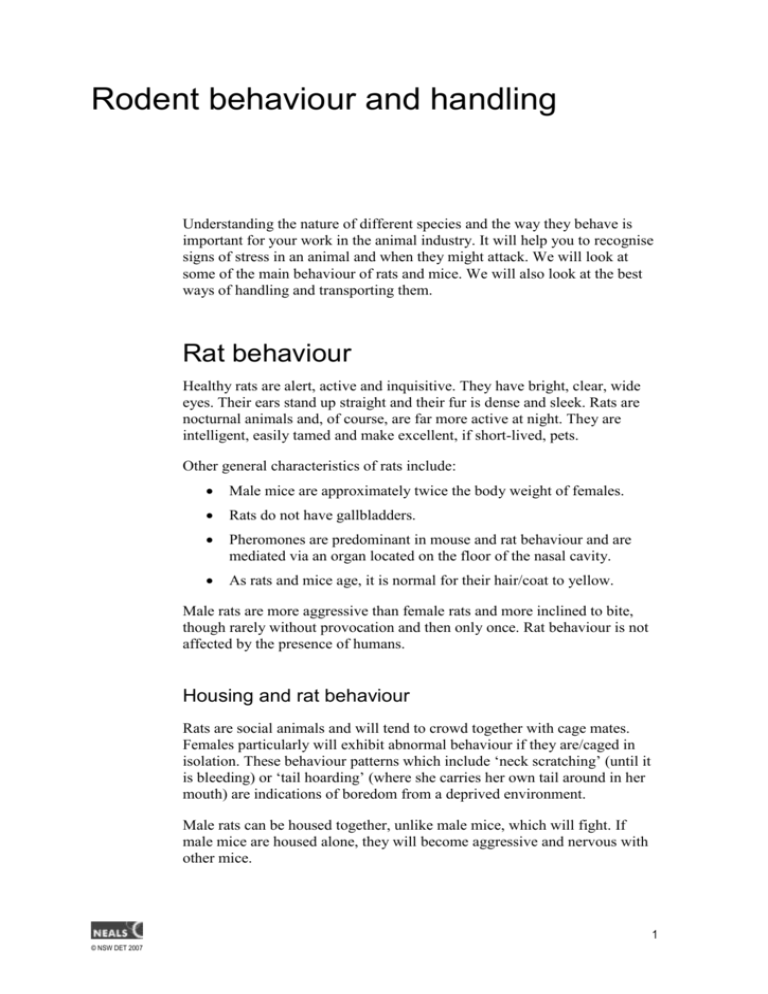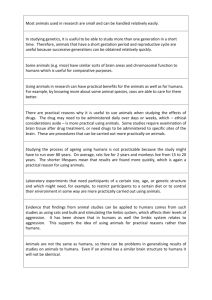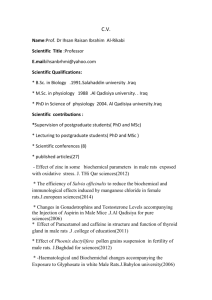doc
advertisement

Rodent behaviour and handling Understanding the nature of different species and the way they behave is important for your work in the animal industry. It will help you to recognise signs of stress in an animal and when they might attack. We will look at some of the main behaviour of rats and mice. We will also look at the best ways of handling and transporting them. Rat behaviour Healthy rats are alert, active and inquisitive. They have bright, clear, wide eyes. Their ears stand up straight and their fur is dense and sleek. Rats are nocturnal animals and, of course, are far more active at night. They are intelligent, easily tamed and make excellent, if short-lived, pets. Other general characteristics of rats include: Male mice are approximately twice the body weight of females. Rats do not have gallbladders. Pheromones are predominant in mouse and rat behaviour and are mediated via an organ located on the floor of the nasal cavity. As rats and mice age, it is normal for their hair/coat to yellow. Male rats are more aggressive than female rats and more inclined to bite, though rarely without provocation and then only once. Rat behaviour is not affected by the presence of humans. Housing and rat behaviour Rats are social animals and will tend to crowd together with cage mates. Females particularly will exhibit abnormal behaviour if they are/caged in isolation. These behaviour patterns which include ‘neck scratching’ (until it is bleeding) or ‘tail hoarding’ (where she carries her own tail around in her mouth) are indications of boredom from a deprived environment. Male rats can be housed together, unlike male mice, which will fight. If male mice are housed alone, they will become aggressive and nervous with other mice. 1 © NSW DET 2007 If rats escape their cage they will return to it for feed and water. Other key points include: Females will often share the mothering duties if housed together, although some prefer to be on their own and will kill the young of others. Rats sleep huddled together during the day to conserve body heat. A normal, healthy rat will sleep curled in a ball. However, a sick animal will usually sleep stretched out. Normal caged behaviour includes running, jumping, standing on hind legs and some climbing if cage facilities allow. When housed in groups they alternate between periods of exploration and lying/sleeping in communal groups. Rats can make very good pets as they like to interact with people and are easy to care for. Regular handling is essential to maintain a bond between the handler and the individual animal. Breeding behaviours Male mice and rats produce a strong odour to attract females and mark territory. Some of the behaviours that relate to breeding are listed below: During the breeding period it is normal behaviour for the male to nibble the female’s head or body and to examine her ano-genital area before copulation. Pregnant females show nest building activity before giving birth (parturition) and during producing milk (lactation). Females in overpopulated environments will withhold oestrous. Impregnated females that are exposed to unfamiliar males will sometimes abort. 2 © NSW DET 2007 Only females have nipples and these are evident at about ten days of age. Young mice and rats are referred to as ‘pups’. To sex young mice and rats, it is common to measure the distance between the anus and the urogenital tract. Males have a greater distance between these two organs. When sexing rats and mice it is obvious in older animals that the male has a set of testicles. In younger individuals, it is necessary to measure the distance between the genital tract and the anus to distinguish males from females. Males have a greater distance than females. Other points About laboratory rats: The laboratory rat (Rattus norvegicus), unlike its cousin the wild black rat (Rattus rattus), is normally docile and easily handled. These docile characteristics have been bred into rats during the 200 years they have been used as a research animal, 100 years of which they have also been used as pets. The behaviour of rats in laboratory conditions depends on how many rats are caged together, the size and type of the cage and the environmental conditions. About albino rats: Albino rats are more photophobic (sensitive to light) than pigmented rats. Albino rats and mice have poor eyesight compared with coloured varieties. 3 © NSW DET 2007 Great care must be taken to support the body weight of rats, particularly pregnant individuals such as this one in the photo. Support the lower body in the palm of the hand while restraining the head and fore limbs with the other hand. Mouse behaviour Mouse behaviour is affected by the presence of humans. They are timid and will bite if frightened. It is easiest if you handle them gently. Understanding some of the basic behaviours of mice will help you to handle them more easily and reduce any potential stress and injury while they are in your care there are some important points to remember: Mice are nocturnal animals and feed mainly at night. Lighting should be kept low. Mice sleep curled up in a ball; sick animals tend to stretch out. Females build nests for their young. Poor diet or maintenance can result in females cannibalising their young. It is normal for mice to climb, stand on hind legs and jump if space permits. Mice, if they escape from their cage, will not come back. Mice normally huddle together during the day to keep warm. 4 © NSW DET 2007 Mice are social animals and can live in breeding colonies, the size of which depend on the floor area of the housing. 5 © NSW DET 2007 Handling and restraint As well as knowing about their behaviour, you need to be familiar with and the main physical characteristics of rats and mice, best ways of handling and transporting them. There will be times when you will need to handle and transport rats and mice. You might need to handle and move them so that you can: transport them clean their cages medicate them weigh them examine and sex them breed them cull them assist with their surgery. Basic handling techniques No matter what species you wish to handle or transport, there are some basic techniques for handling animals safely and avoiding injury to yourself or the animal. When handling an animal you should: Hold it in such a way as to avoid stress and discomfort to the animal while allowing the animal to be safely examined and treated. Allow the animal to feel comfort and in control whilst you handle it securely. In this way, the animal will respond best to your needs. Avoid stressing the animal and reduce the possibility of injury to yourself and the individual animal––wherever appropriate, use personal protection equipment. Be gentle but firm and confident in your actions. Mice are particularly quick to move and should be handled in an enclosed area so that if they escape, they can be recaptured easily. Some of the items you might use to handle and restrain rats and mice include: your hands, rat or mouse bag, small towel or rat and mouse restrainers. 6 © NSW DET 2007 Handling mice When handling mice, use the forefingers and grasp the base of the tail firmly. Lift the mouse and place onto a wire surface––as mice can turn around and climb up their own tail and bite the handler. As the mouse holds onto the wire and extends forward, grasp the loose skin at the back of the neck and shoulders. Mice accustomed to being handled can be picked up in the palm of the hand. Mice may be held in the corner of a small clear plastic bag with the corner cut out to allow them to breath. This will allow a good view of them and give the opportunity to give injections through the bag, without causing undue stress to the animal. Familiarity is a useful tool when wanting to handle small animals. Once they become accustomed to the handler’s presence, they will be less stressed by handling and will sit quietly in the palms of the hands—as the mice is doing in the photo below. The photo below shows a good way of picking mice up—grasp the tail gently but firmly, to lift the hind limbs off the ground and allow the forelimbs to grasp a solid object. 7 © NSW DET 2007 The skin on the tail of rats and mice is very sensitive and great care must be taken to avoid damage to this area. Injury could result in amputation of the tail. Handling rats Pet rats are usually social and don’t resent handling. They respond well to confident and gentle handling. They are easily frightened by the sudden appearance of reaching hands and rough handling and the associated high frequency sounds. When frightened or cornered, they may become aggressive and are able to inflict deep bites. Other points include: They can be picked up by placing your hand under their belly and lifting them up. 8 © NSW DET 2007 To restrain, place your forefinger under the jaw and your thumb under the forearm on the other side––similar to how one would grip a bird. Additional support should be given by holding the tail and hind limbs with the opposite hand. A small handtowel may be thrown over them and they may be picked up in this if they are very timid. Rats may be held in the corner of a clear plastic bag with the corner cut out to allow them to breath. This will allow a good view of them and give the opportunity to give injections through the bag, without causing undue stress to the animal. They squeal if in pain and if squeezed too tightly around the chest tend to bleed from the nose. Active or aggressive rats Active rats may need to be caught initially by grasping the base of the tail as you pick them up. If a rat is aggressive it is usually because of mishandling and a frightened rat will always bite. Even aggressive rats will respond to gentle handling and can usually be quietened with a gentle approach. They are social animals and fighting between animals of the same sex––even old breeders––is minimal. Note: Avoid causing injury to the tail which can happen by rough handling. The skin in this area is very fine and easily abraded which may result in amputation of the tail and significant blood loss. This photo is of an a hooded rat—appropriate initial handling techniques will greatly affect the future behaviour of individual animals. 9 © NSW DET 2007 Transporting rats and mice When you are working out what the best way is for transporting a particular rat or mouse think about the following: The age and gender of the animal will effect transportation. Young or pregnant animals will need special consideration as stress will have more of an impact than with mature non-pregnant animals. If travelling long distances, consideration needs to be given to the provision of food water and rest breaks. Dry feed and fruits and vegetables that have high water content can be placed in the cage with access to water provided during rest stops. Should the animals need to be transported by plane or road transport, ensure the most direct route possible is chosen to minimise travel time. The transport company needs to know that they are transporting live animals and the cages marked to identify them. Ensure that the receiving party is aware of the arrival time so that the animals can be collected promptly and settled in their new quarters with as little delay as possible. Before transporting, provide the animals with bedding and some shredded paper in which to hide. Travel destination––eg from pet shop to home; from home to Veterinary clinic; from breeding establishment to research facility–– will affect the arrangements you need to make. In the animal house or veterinary clinic, the use of a fully enclosed cage is recommended—even quiet animals can be easily frightened. Schedule the journey for the coolest part of the day, as rats and mice are affected by heat. (This may not be possible in the event of a medical emergency). The cage needs to be secure, escape proof, provide protection from predators and be well ventilated but not draughty. Covering the cage to make it darker will help reduce the stress suffered. If cardboard boxes with holes punched in them for ventilation are used, make sure that the journey is only a short one (or they may chew their way out) and the weather isn’t too hot. 10 © NSW DET 2007 A solid-sided lightweight carry box—as can be seen in the photo above— with a secure lid is recommended for transporting rats and mice. Bedding, food and water are all essential when travelling for a period of time. It is also important to monitor ventilation and temperature. When you are transporting an animal, you need to ensure the following: protection of the animal from other animals, people and adverse environmental conditions sufficient spaces for the animal to stand, stretch and fully turn around sufficient quantities of food and water given at appropriate intervals prompt veterinary or other appropriate treatment in case of illness or injury maintenance of hygiene in holding pens, vehicles and equipment is of major importance supervision of feeding, watering and inspection of animals to ensure wellbeing. Weighing rats and mice Weighing individual rats and mice may be necessary from time to time. The most effective way to weigh these animals is to follow these simple steps: 1 Place a small cardboard box onto a very sensitive set of digital scales— as you can see in the photo below. 2 Zero the scales so that they do not register the weight of the box. 3 Place the individual to be weighed inside the box. 4 Note the total weight of the animal. 11 © NSW DET 2007 5 Return the animal back to its home cage. The photo below shows an example of where quiet, well handled animals may be placed directly onto the scales. Care must be taken to ensure that they do not fall off or escape. 12 © NSW DET 2007






